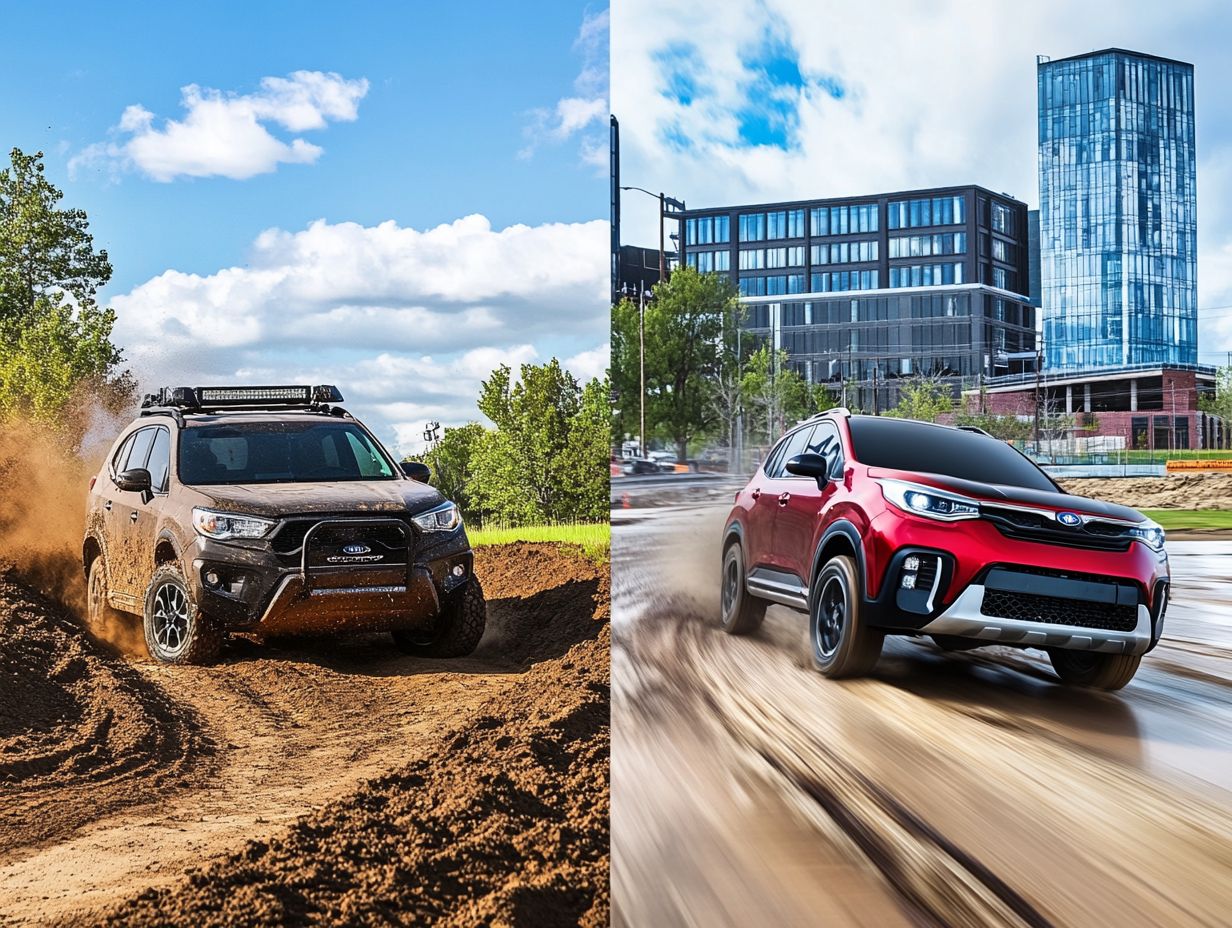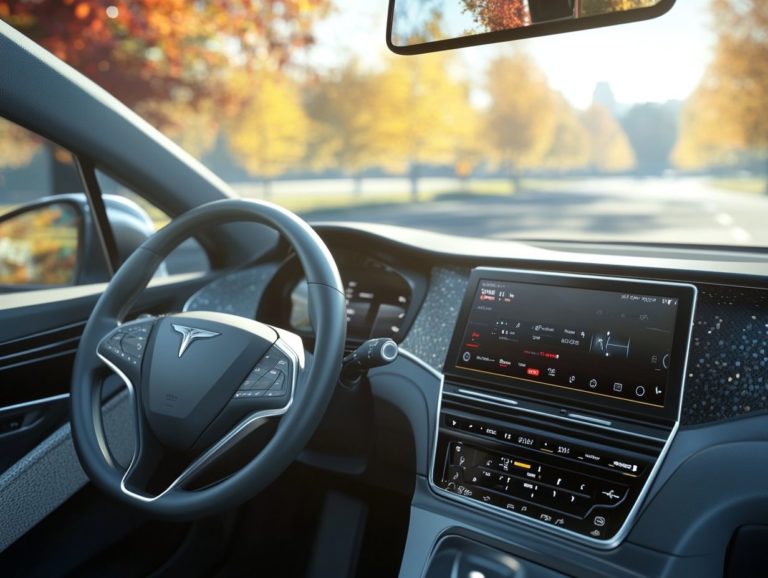Feature Comparison: AWD vs. FWD Vehicles
When selecting a vehicle, the drivetrain is important in affecting your performance, efficiency, and overall driving experience.
All-Wheel Drive (AWD) and Front-Wheel Drive (FWD) are two popular choices, each with distinct advantages and disadvantages. This article delves into the essential differences between AWD and FWD, focusing on handling, traction, efficiency, and cost.
By examining these elements, you can tailor your decision to align with your specific driving needs and preferences. Whether you navigate icy roads or glide through urban landscapes, understanding the nuances of these drivetrains can significantly enhance your driving experience.
Contents
- Key Takeaways:
- Performance Differences Between AWD and FWD
- Cost Comparison of AWD and FWD Vehicles
- Factors to Consider When Choosing Between AWD and FWD
- Frequently Asked Questions
- What is the difference between AWD and FWD vehicles?
- What are some benefits of AWD vehicles?
- What are some advantages of FWD vehicles?
- Do AWD and FWD vehicles have different maintenance requirements?
- Which type of vehicle is better for off-roading?
- Is one type of vehicle better than the other for towing?
Key Takeaways:

- AWD vehicles provide better handling and traction on various road conditions, making them ideal for harsh weather. FWD vehicles offer better fuel efficiency and are more budget-friendly.
- Purchasing an AWD vehicle may have a higher upfront cost, but it can save you money in the long run due to lower maintenance costs. FWD vehicles have a lower purchase price but may require more frequent repairs.
- The decision between AWD and FWD depends on factors such as climate, driving conditions, and personal preferences. Consider your needs before choosing a vehicle to ensure the best fit for your lifestyle.
What are AWD and FWD?
All-Wheel Drive (AWD) and Front-Wheel Drive (FWD) are two distinct drive systems that greatly impact your vehicle s performance, handling, and traction in conditions like snow and mud. Car manufacturers design vehicles with these systems to meet diverse driving preferences, ultimately enhancing your driving experience and safety.
AWD systems truly excel in traction, distributing power to all four wheels. This feature is particularly beneficial in slippery conditions like snow or rain, resulting in improved stability and acceleration. Many high-performance luxury sedans and sports cars feature AWD technology to deliver an exceptional driving experience.
On the other hand, FWD primarily engages the front wheels. This offers solid handling in standard driving situations but may face challenges in extreme conditions. Both systems play essential roles in determining a vehicle’s suitability, influencing your choices if you prioritize performance and reliability.
Performance Differences Between AWD and FWD
The performance differences between All-Wheel Drive (AWD) and Front-Wheel Drive (FWD) vehicles are significant. These distinctions influence handling, traction, and overall driving dynamics in various conditions, including snowy or muddy terrains.
Understanding these differences can enhance your driving experience, ensuring you choose the right vehicle for your needs.
Handling and Traction
When you consider handling and traction, AWD vehicles truly stand out. They distribute power to all four wheels, offering enhanced grip in challenging conditions compared to FWD or rear-wheel drive systems.
This capability shines on steep hills or when navigating loose surfaces like gravel and snow, where improved traction provides a more stable and confident driving experience.
While AWD excels in tough situations, FWD vehicles hold their own under normal driving conditions. Their lighter weight often translates to better fuel efficiency and easier handling on smooth, paved roads.
The forward weight distribution in FWD systems aids in maintaining control during acceleration, but it can struggle with sudden turns or inclement weather. By understanding these distinctions, you can make a more informed choice about the system that best suits your driving needs.
Efficiency and Fuel Economy

Efficiency and fuel economy are pivotal when you re weighing the merits of AWD versus FWD vehicles. Generally, FWD cars take the crown for better fuel efficiency, thanks to their lighter weight and simpler drive systems.
This advantage is especially clear in compact sedans and hatchbacks. FWD configurations can easily achieve an average of 30-40 miles per gallon. In contrast, AWD vehicles, built for superior traction and stability, often trade some of that efficiency, averaging around 22-28 miles per gallon.
Take the Subaru Impreza; this well-regarded AWD compact often lags behind its FWD rivals, like the Honda Civic, in fuel economy. In urban driving situations, where FWD systems shine, the fuel consumption of AWD vehicles can rise significantly due to their additional weight in stop-and-go traffic.
Cost Comparison of AWD and FWD Vehicles
When you evaluate the cost comparison between All-Wheel Drive (AWD) and Front-Wheel Drive (FWD) vehicles, consider factors like purchase price and maintenance costs. These play a crucial role in overall affordability and long-term value.
Such factors can influence your decision, shaping your initial investment and the financial implications over time.
Purchase Price and Maintenance Costs
The purchase price for AWD vehicles often exceeds that of FWD vehicles. This is primarily due to the complicated AWD system and the maintenance costs associated with it.
You ll quickly see that models like the Subaru Outback or Audi Q5 often carry a premium, typically ranging from 5% to 15% more than their FWD counterparts like the Honda CR-V or Toyota RAV4. AWD vehicles cost more because they use advanced technology and need extra parts.
For example, while FWD systems are generally easier and less expensive to service, AWD vehicles can incur higher repair bills due to their intricate mechanics. Understanding these factors can shape your decision when weighing the choice between these drivetrains.
Factors to Consider When Choosing Between AWD and FWD
When considering All-Wheel Drive (AWD) versus Front-Wheel Drive (FWD), pay attention to several critical factors. Consider the climate, the driving conditions, and your personal preferences.
Each of these elements can sway your decision regarding vehicle power and performance.
Climate and Driving Conditions

Climate and driving conditions are crucial in deciding whether all-wheel drive (AWD) or front-wheel drive (FWD) is right for you, especially in regions with harsh weather or challenging terrains.
Consider the Rocky Mountains in winter, where heavy snowfall is common. In such environments, an AWD system provides you with exceptional grip and stability, enabling you to navigate icy roads confidently.
FWD may hold its ground in milder climates or on well-maintained roads, but it can struggle under adverse conditions, such as heavy rain, increasing the risk of hydroplaning.
In urban areas, where rainwater tends to pool, the superior traction of AWD can greatly enhance your driving safety. For those who enjoy off-road adventures, AWD systems are invaluable, providing the support needed to tackle rugged terrains while ensuring superior control.
Think carefully about these factors before making your choice!
Personal Preferences and Needs
Your personal preferences and needs are key factors when choosing between AWD and FWD systems. These choices often depend on your lifestyle and driving habits.
If you drive in the city a lot, you ll love the fuel efficiency and ease of handling that FWD vehicles offer. But if adventure calls, consider AWD for better traction and stability on rugged terrains and during bad weather.
AWD systems are perfect for those who crave swift acceleration and sporty performance. Understanding how your driving style interacts with vehicle features helps you make the best choice for your needs.
Frequently Asked Questions
What is the difference between AWD and FWD vehicles?
AWD means all-wheel drive, where all four wheels get power from the engine. FWD stands for front-wheel drive, meaning only the front wheels get power.
What are some benefits of AWD vehicles?

AWD vehicles offer excellent traction and handling in poor weather, such as rain and snow. They also provide better performance on both dry and wet roads.
What are some advantages of FWD vehicles?
FWD vehicles are usually more fuel-efficient and cost-effective. They also excel in tight spaces, making them ideal for city driving.
Do AWD and FWD vehicles have different maintenance requirements?
Yes, AWD vehicles can need more frequent maintenance due to their complex drivetrain. However, this depends on the vehicle’s make and model.
Which type of vehicle is better for off-roading?
AWD vehicles are generally the best choice for off-roading because of their power distribution to all four wheels. Some FWD vehicles with advanced traction control can also perform well off-road.
Is one type of vehicle better than the other for towing?
AWD vehicles usually have a higher towing capacity because of their increased power and stability. However, towing capacity ultimately depends on the vehicle’s design.






